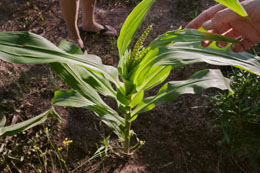Categorized as a hardy houseplant variety, a corn plant requires minimal effort and easy gardening tips. Here are some tips on caring for a corn plant.

A corn plant, also commonly known as
Dracaena, grows both in indoor and outdoor conditions. Belonging to the
Agave family and represented as
Dracaena fragrans, it is a tropical plant species popularly grown as houseplants for its attractive foliage. The stem is erect, brownish in color, and bears bright green, lanceolate leaves at the top. The plant resembles a corn stalk, hence the name. You can identify these plants from the yellowish band present in the foliage, which runs along the length of the leaf.
You should understand the basic necessities of growing a corn plant before you indulge in actual growing. Even though the detailed growing requirements vary according to species, one thing common to all varieties is that they grow best in low light. Hence, they are ideal houseplants, which you can place in room corners and hallways. They grow to a maximum height of about 20 feet.
Frankly speaking, these plants require little care and maintenance. Hence, even if you have a hectic schedule and have less time, you can grow healthy plants. An important note is that all types of corn plants are poisonous, thus requiring you to keep these plants away from children and pets.
Ideal Pot
The roots of corn plants are shallow and borne very close to the cane. They can be grown in small pots in the initial growth stages. However, when the plants height increase, you need to repot them in larger size containers, so that the weight of the top portion is balanced properly with the bottom portion. A corn plant having a height of 9 feet can be grown in a 16-inch pot.
Potting Soil
After pot selection, the next step is preparing potting media. Your aim is to make well-drained, fertile, and loose soil. Consider mixing garden soil with peat moss to get the required soil texture and fertility. In case of poor quality soil mixture, supplement it with a liquid fertilizer in correct concentrations, as prescribed in the product label.
Lighting
As mentioned already, these plants need low light. You can place them in areas that receive filtered sunlight for better growth. As far as temperature is concerned, it requires warm conditions. When exposed to very cold conditions, leaf dropping is observed. As they are native to tropical climates, the optimal temperature range is close to their native habitat, about 20 to 25 degrees Celsius.
Watering
Moderate watering is sufficient to maintain healthy plants. You can consider irrigating them once in 7 to 10 days or whenever the top soil is dry. Watering should be done to such an extent that the upper soil layer (about 1 inch) is moistened. Overwatering causes yellow coloration of the foliage. Hence, if you notice such a condition, reduce watering frequency.
Propagation
Propagation is mostly done by stem cuttings, preferably in spring. When your plants are matured enough, you can cut the stems with a sharp blade. Then, prepare a potting mixture and insert the twigs in the soil. Most probably the new stem cuttings will root within 2 to 3 weeks.
Disease and Pest Problems
One of the advantages is that these plants are highly resistant to pest and diseases. Hence, if you provide the ideal growing conditions, your plants will grow healthily without any signs of infestation. At times, when they are exposed to stress, spider mites and bugs can infest them. In such incidences, spray the affected parts with a dilute solution of regular dishwashing soap and water.
Follow the above tips along with regular misting and cleaning of the foliage. If necessary, you can think of pruning them to manage their height. When matured, corn plants may bear scented, yellow colored flowers in panicle inflorescence.






 A corn plant, also commonly known as Dracaena, grows both in indoor and outdoor conditions. Belonging to the Agave family and represented as Dracaena fragrans, it is a tropical plant species popularly grown as houseplants for its attractive foliage. The stem is erect, brownish in color, and bears bright green, lanceolate leaves at the top. The plant resembles a corn stalk, hence the name. You can identify these plants from the yellowish band present in the foliage, which runs along the length of the leaf.
A corn plant, also commonly known as Dracaena, grows both in indoor and outdoor conditions. Belonging to the Agave family and represented as Dracaena fragrans, it is a tropical plant species popularly grown as houseplants for its attractive foliage. The stem is erect, brownish in color, and bears bright green, lanceolate leaves at the top. The plant resembles a corn stalk, hence the name. You can identify these plants from the yellowish band present in the foliage, which runs along the length of the leaf.